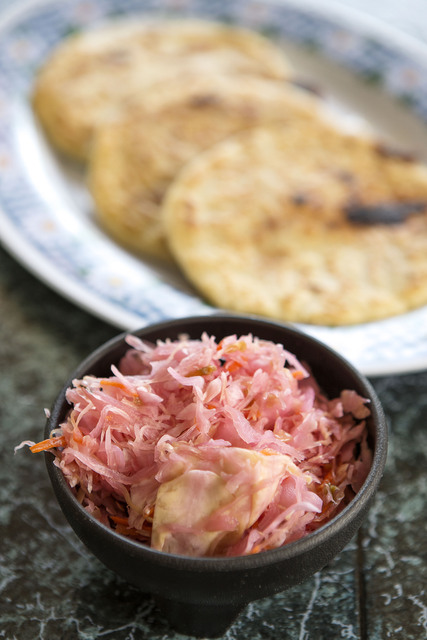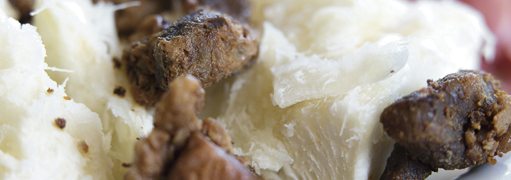Many probably noticed, if not sampled, the food once served at Pupuseria y Resaurante Salvadoreña on Gibson. It was in a conspicuous location, the corner of San Mateo that’s also inhabited by a blue arch with a Chevy on top. This satellite restaurant closed not long ago, while the original Pupuseria y Restaurante Salvadoreña still lies in the South Valley on Bridge Street. As I was a fan of the Gibson place, I decided a trip to the mothership was in order.Pupusas are a distinguishing characteristic of the cuisine of El Salvador. They’re basically an extra-thick tortilla stuffed with goodies, like cheese, pork, green chile, chicharrones, chicken, beans, fish, shrimp, calabacitas, ground beef and a Central American flower called the loroco.We ordered several pupusas. The loroco was subtle and tasted faintly of asparagus. My favorite was the revuelta, which contains a mix of chicharrones, cheese and beans. The shrimp and calabacita pupusas were excellent as well. Both of these pupusas are seasoned with black pepper and have tomato in the filling, which adds contrast and a little acidic bite to the pancake-sized discs.The pupusas are served with a mild, chick tomato purée. Several of the dishes, like the chicken gizado, are cooked in tomato sauce. The gizado sauce contains olives, which I like to think betrays a Mediterranean origin—like Mexican food, Salvadoran cuisine is a mix between indigenous and Spanish, with a sprinkling of other cultures chipping in. The gizado contained large chunks of chicken. The sauce penetrated the flesh, delivering a hint of spice and a bouquet of savory flavors. It’s a delicious, satisfying dish, and I preferred it to the steak gizado, which is also on the menu.Most of the platos, including the gizado, come with Salvadoran tortillas, which are almost as thick as pupusas, and a generous side of curtida, a kind of Salvadoran pickled cabbage. It’s pink, tangy and meant to go with pretty much everything. Veggies in general are a strong suit here, and most plates come garnished with salad-sized piles of fresh cut plant matter. Another side that shines in many dishes are the refried beans, which are rich, salty and curiously fulfilling.There are tamales on the menu as well, including the tamal de elote, a tamale with no filling, in which the massa is sprinkled with shards of sweet corn kernels and served with crema, which is something like a mild, rich sour cream. There is also the tamal Salvadoreña, a hearty tamale stuffed with large chunks of chicken and olives, but good luck getting your hands on one. This popular item is usually sold out.The South Valley location has a more, shall we say, worn-in feel to it than the Gibson satellite, which was spiffy by comparison. The walls are adorned with an eclectic menagerie of knickknacks and objets d’art, including a rusty tuba, a shiny machete, a mural depicting a Salvadoran agricultural scene and a modern, printed banner of San Salvador by night. There’s also a case in which jars of Salvadoran olives and hearts of palm are sold alongside bags of dried Salvadoran beans, presumably the same variety that are so deliciously refried by the restaurant.The menu is littered with pleasant surprises, many of which appear on the list of drinks, which has considerably more options than what most latino restaurants can muster. There is a menu subsection full of vegetable juice mixes made from permutations of carrot, celery, apple, orange and even beet. There are also aguas frescas on the menu, as well as espumas de leche, or milkshakes. Like the juices, the espumas arrive in classy tall glasses.Another pleasant surprise was the fried yucca off the appetizer menu. Yucca is a sweet and starchy tuber that was an aboriginal staple throughout Central and South America and became a part of modern cuisine throughout the Latin American tropics. Yucca is nice boiled as well—and that option is available at the pupuseria—but fried yucca is something special. The crispy pieces are reminiscent of French fries, and when done right fried yucca is vastly superior. And the Pupuseria does fried yucca right, even mixing in a portion of chicharrones among the similarly crispy yucca pieces.Speaking of fried, the fried whole tilapia, mojarra frita, can feed a lot of people, served as it is with the works: curtida, tortillas, refried beans and salad-sized garnish.Most people don’t think “seafood” when they think of Salvadoran cuisine. But let’s be honest, most of us don’t, or haven’t given much thought to Salvadoran cuisine period. The Pupuseria will change this. The mariscada, a fish and seafood soup, is so thick with ocean creatures that your spoon can’t help but bump into saltwater proteins with every probe. It comes in a tomatoey broth that’s spicy and creamy. It’s an altogether decadent bowl of soup.One final bowl of soup on the menu had escaped my attention until I was out of town, working on this review and looking at a photo I had taken of the menu. “Saturday and Sunday,” read the menu, “Sopa de Pata.” Duck soup.It felt like a major oversight to not be able to comment on the duck soup, so I contacted a team of soup specialists I often work with and sent them to inspect for me.They were, in the words of the one who I’ll call Agent 1, “… totally stoked to try the duck soup, or sopa de pato. We are very big duck fans. We will eat duck at any time, and in any form.”Unfortunately, there was an error in my translation of the word “pata.”“What we got was sopa de pata, which doesn’t have duck in it at all. It was an offal soup,” observed Agent 1. Offal, for those that don’t know, means guts. “It’s not for everyone,” Agent 1 added.His partner was not a fan. “Those meat flavors and textures are not my gig. … My brain said ‘don’t swallow that.’"But Agent 1 clearly has a soft spot for gut soup.“There are several large chunks of squash, corn on the cob, carrots and yucca, with a generous amount of cabbage leaves floating in the salty broth.“The stars of this dish are the soft tissue of cows feet and tripe. A couple of knuckle bones sat at the bottom of the bowl. The foot tissue was gelatinous, melted in the mouth and reminded me of the beef tendon we all shared at Chopstix, except that it was softer and more easily liquified on the tongue. It had the mild flavor of beef fat and was very enjoyable.”He praised the beef menudo for not being “… the bleached, chewy, flavorless tripe we usually see floating in menudo. It’s slightly darker in color, and it is fall-apart tender, just dissolving in the mouth. It does, however, have a mild aroma and taste of a barnyard. It is not overpowering, and it smells no worse than a good goat cheese, but its presence is distinct.“My only complaint,” he added, “… is that it had no duck.”
Pupuseria y Restaurante Salvadoreña
1701 Bridge SW
243-8194
Hours: 10am to 7:30pm Monday through Friday9am to 8pm Saturday and SundayAmbiance: Homey, and a lil’ grungyVibe: Cheerful and friendlyPlastic: SiBooze: NoOutdoor seating: Yes, if you want to fry yourself crispier than the yucca. The Weekly Alibi recommends: Pollo gizada, pupusas: revuelta and calabasitas, fried yucca, mariscada, tamal Salvadoreña













